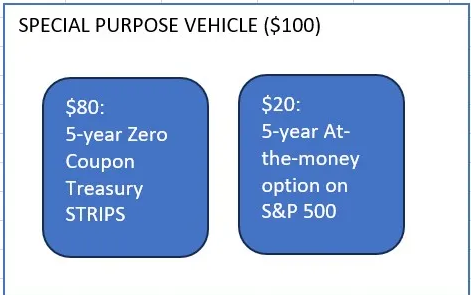LENZ stock tumbles after retinal tear case surfaces in FDA database
There’s an aspect of the higher interest rate structure we are now blessed/cursed with that hasn’t gotten as much airplay, but which is great news for dealer desks and also a good thing for institutional investors (and some high net worth individual investors). And that is the new energy that the higher rates will inject into private note structured product.
A classic structured note is typically designed so that the buyer is guaranteed to get his money back, plus the possibility of some more-attractive payout. So, for example: I might issue a note that will pay you 60% of the total gain in the S&P 500 over the next 5 years – but if the S&P is lower in 5 years, you still get your money back. That’s a pretty simple version, but the embedded bet can be as exotic as you like (and from the standpoint of the dealer, the more exotic, the better because the harder it will be for you to price it and the more profit, therefore, they can book on it).
When I was tasked with issuing notes from the Natixis Securities (North America) shelf, for example, we offered a 10-year note that redeemed at either the total rise in the CPI over those 10 years or the average return of the S&P, Nikkei, and Euro Stoxx 50, or par (100%), if both of the other two possibilities were negative.
I recall another dealer in 2007 or 2008 was selling a 1-year note that had a huge coupon as long as inflation was between, say, -1% and +3%, but zero otherwise. But you still got your money back. You could structure something with knock-out options, average-price or best-of or lookback options – on interest rates, equities, commodities…even an option on a hedge fund. I want 20% of the latest global macro fund’s upside but with a guaranteed downside.
The key ingredient to all of these things, though, is interest rates – and when interest rates are very low, it is difficult to make a structured note look attractive.
Once upon a time, like back at Bankers Trust in the mid-1990s, the way a structured note was created was to make a special purpose trust that held two securities: a zero-coupon Treasury bond with a maturity equal to the note’s maturity and ‘something else’ – usually an option. The investor would invest $100. The dealer would spend $80 on the zero coupon bond…which, since it matures at par, guarantees the principal…and has $20 left over to spend on anything else that couldn’t decline below zero. Classically, this is an option, so the trust would look like this:

Since the option can’t be worth less than zero at maturity, and the STRIPS is guaranteed to be worth $100 at maturity, this bond is principal guaranteed by construction and has no credit risk. Any value the option has at the end of the term is an add-on. If the option is worthless, then the bond matures at par. So simple.[1]
You can see why interest rates matter. This 5-year zero-coupon bond at $80 implies that it is priced at a compounded interest rate of 4.56% (because $80 * (1+4.56%)^5 = $100). But suppose that 5-year interest rates are 0.75%, as they were two years ago at this time? Then the 5-year coupon bond will be priced at 96.33, and instead of having $20 to spend on options, the structurer will have less than $4. There aren’t a lot of options priced at $4 that will be exciting enough to an investor (or have enough spread to be exciting enough to a dealer). Never mind the fact that in all of this, I have neglected that a dealer generally also gets paid to underwrite and distribute the bond so that $1 or $2 will come off the top. In this last example, the dealer doesn’t have $3.67 to spend on options…it probably has only $2. Good luck.
I present the notion behind structured products that way because it’s easy to conceptualize and because that’s the way the concept started, but it has been a long time since dealers actually used zero-coupon Treasuries in such a structure. The way such a note is made today is driven by the credit of the issuer, so the structured note trust really holds an IOU from the borrower. In most cases, this is the dealer itself, but there are other companies who will issue in their name in order to get bargain financing rates (once the dealer hedges away all of their risk). The mechanics are not worth going into here: if you are someone who would care, you probably already know how to do it, and most of you won’t care. The significance is that the structurer can get a little more spread to play with since the interest rate will be a corporate credit rather than a government bond. But still not lots.
However, now interest rates are back up. United States 2-Year Treasuries are at 4.90%, 3-Year is at 4.50%, and 5-Year at 4%. That’s back to the way it used to be. Even real rates are meaningfully positive. Implied volatilities are generally low as well. All in all, structuring desks doubtless have a lot more to do these days than just a few years ago. Not everyone hates higher rates!
[1] Since this column generally concerns itself with inflation and real variables, I should point out that you can also guarantee par in real terms by substituting a TIPS STRIP or the derivative equivalent, so that the investor will get at least the inflation-adjusted amount of his money back rather than the nominal amount; however, then the structurer will have less premium to play with.
